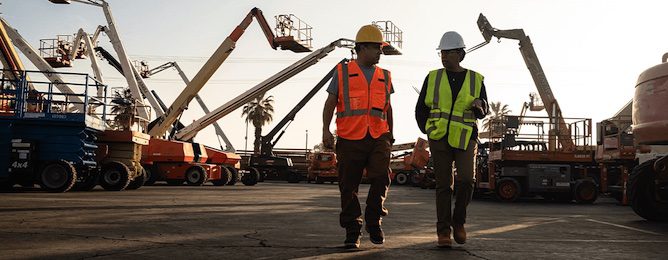

I’ve been championing sustainability within Trackunit’s four walls for some time now. That might make it sound like I was dealing with an unreceptive audience but nothing could be further from the truth.
The desire to make something happen was very evident. We have, after all, been developing sustainable solutions via a more efficient sharing economy for rental companies ever since we were founded in 1998. What is perhaps more evident is that up until now, we’ve not been that good at articulating it, at least in ESG terms.
But while we’d established the ‘why’ for a sustainability strategy, we were some distance away from formulating the ‘how’ and the ‘what’. I’ll explain in this post why we’ve made real progress with the ‘how’ and it will be the progress we make with the ‘what’ which will probably represent the next big stage of the movement.
As far as the ‘how’ is concerned, we’ve deliberately focused on creating a framework for engaging with industry organizations where we approach the issue from a holistic perspective, but are simultaneously fully focused on delivering tangibles.
The talks — in the form of round tables, workshops and hackathons — are a channel for funneling ideas, creating priorities and then establishing a portfolio of ideas that, through a construction-wide approach, we can hopefully implement.

It might sound counter intuitive given the process begins with a conversation but we are genuinely more interested in action — a commitment to solving the real problems rather than the symptoms. Ultimately we want to be useful by being a part of creating something that will make the construction industry known for social responsibility. If there’s no action, then the discussions will have not done what they set out to achieve.
But, if the ideas the industry generates become part of a new status quo through the entire construction value chain, then we’ll have made a very good start to what we want to do.
But that’s all it will be — a start. We’ve much bigger ambitions than this.
The growth of the telematics sector doesn’t need elaboration here. Suffice to say that we at Trackunit are at the heart of the development, and the connectivity that flows from the data will be the driver of the next stage of sustainability.
The data is naturally at the core of the industry’s mission to eliminate downtime, but it’s self-evident that any process that leads to more efficiency, is by definition creating a more sustainable sector as machines that idle less also emit less CO2 and particles.
There are dynamics at work that are helping accelerate this process and making it real. The role of legislation first of all cannot be underestimated and it helps establish a regulatory framework that means companies have to take certain measures to foster better solutions if they want to walk on the right side of the line.
Then there are the new wave of companies with business models fully integrated into a sustainability framework where every move is underpinned by the rationale.
And finally there are the incumbents. The likes of Trackunit, the OEMs, the contractors and rental fleet owners who can influence through their own behavior the way the sector develops.
Whatever the relative merits of the three dynamics, and different people argue differently for which might be most important, together they are critical and bounce off each other to create a more sustainable industry.
And I think it will become easier for the industry to become more sustainable if people in power actively lean into the paradox of competition and collaboration. One way to think about this is through coopetition, a new word used to describe the paradox of cooperative competition.
What matters in competition is not so much the change in technology but the behaviors and practices that it enables so that, for example, being data driven is more important than owning a data lake. Collaborating on development of technology can therefore be a competitive advantage.
There are gradual shifts in the construction life cycle in the meantime that are catalyzing the transition to better building standards and processes.
This may be a simplistic way to look at construction but in essence, you can boil it down to the building phase and the operational phase. It’s the operational phase — the maintenance, utilities and other running costs — that actually accounts for the lion share of construction’s contribution to global CO2 emissions which, at 38%, is clearly an area we can and must improve on.
But this is already happening. Architects, builders and designers working in unison are getting better at building infrastructure that is easier to disassemble, is more efficient in its utilities usage, and offers a more long-term solution to the waste and inefficiency that has dogged the industry in recent decades.
Returning to that construction phase, our research indicates that it is responsible for 0.5-3.4% of emissions depending among other thing upon whether you include transportation of equipment. But we shouldn’t take that as an excuse to shift all the blame towards the operational phase as firstly, the shift towards better ways of building will in time cut back on its CO2 emissions inevitably increasing the share of the initial phase in overall emissions. Secondly, a glance across all construction projects at any given time and any given place in sheer volume terms translates to a lot of emission, no matter its proportion of overall emissions. And thirdly, we can still be better. It’s, to put it bluntly, the right thing to do.
So how do we address the ‘what’ in our earlier conundrum at the outset of this piece?
One possibility is the creation and acceptance of an energy usage effectiveness metric that can be used across the industry to measure exactly how efficient we are being at any stage of the construction process.
This is no easy task. To pretend otherwise would set us up for a fall and create an expectation that would be very difficult to manage. But we are working on it and devoting serious resource to the matter because we can clearly see how, theoretically at least, the data lake is the key to making it possible, harmonizing the data and putting us in reach of an equation where we compare total energy used by a fleet on a job site with energy used for actual work and benchmark that against another jobsite.
It may be that we have to establish different kinds of metrics for different kinds of construction and for different stages of the process to make it feasible, where, for example, true utilization of earth moving and powered access differ by design. It might be that a proxy like an output-per-square-meter formula provides a, perhaps crude, but nevertheless common metric that the majority, if not all of the industry can sign up to.
There are other possibilities too. Could emissions be divided by revenue? Number of staff? Other criteria?
The discussion generated shows that for now, anything is possible, but we will also have to get to a stage where the industry filters down and devotes its time to something we can actually deliver.
Getting something we can use across construction is the ideal. Looking ahead, the necessary sensor points fitted to machinery need to be de rigueur enabling fleet owners to manage and report their CO2 emissions with accuracy on as many machines as possible. Then there is the two issues of smaller pieces and older pieces of equipment. For both we are looking into using advanced technologies for estimating proxy usage based on multiple data points, for example, analog inputs, data from similar machines and OEM validated fuel rates.
There’s an extremely powerful business case for owners to be on board with this, based not just on costs, the bottom line and competitiveness, but also taking into account governmental requirements to cost budgets in ESG terms. No-one is discounting that this is a process, but as more and more contractors invest in data-rich machinery, the more we can understand the feedback and use it towards creating sustainability-based KPIs and the development of an industry-standard metric that all stakeholders can buy into.

And new business models that prioritize, say, electrification over diesel engines will also help that process. The industry just has to find a way of managing the inevitable cost that this will entail and look to enable the transition over time. For example, infrastructure for electric or hydrogen vehicles needs to be rolled out on a countrywide basis, and retrofitting new drive trains and electrical engines into older diesel machines also needs to happen on a larger scale.
We also anticipate third parties entering the fray at some stage invoking Campbell’s Law. The law states that, the more important a metric is in social decision making, the more likely it is to be manipulated. It will be the third parties that will effectively refine and, hopefully, improve on how any metric that becomes established is measured and used. It will in effect be a self-perpetuating process driven by business sense, ethics and morality, and a desire for something better.
Don’t underestimate what can be done here. If basic rules, guidelines and a unifying metric emerge, that will filter down the pyramid. Whether you’re a fleet owner in Zambia, a contractor in Canada or an architect in Japan, the case is compelling, It’s just about bridging that gap between where we are now and where we want to be.
If you want to stay up to date on events of the Eliminate Downtime initiative, I encourage you to sign up to our newsletter.


Be first to hear about product launches, updates, and industry insights